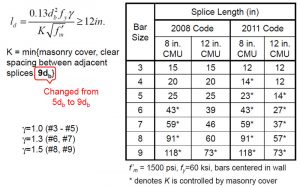
Is it true that the development length has decreased in the 2011 MSJC Code? What about the 2013 MSJC Code?
Yes, it is true that the development length has decreased from the 2008 MSJC Code to the 2011 MSJC Code, however there has been no change between the 2011 MSJC Code and the 2013 MSJC Code.
We consulted with Dr. Richard Bennett, Professor of Civil and Environmental Engineering at the University of Tennessee and Chair of MSJC, on why this change was made.
Dr. Bennett provided a little historical perspective. The “old” development length equations (such as 0.0015dbFs, dating back to the original MSJC Code in 1988) were based on a bond stress. Multiple test projects indicated that this could be unconservative for larger bar diameters. The reason is that the failure with larger bars is not a bond failure, but a splitting failure. These tests resulted in the development/splice equation that first appeared in the original Strength Design provisions of the 2002 MSJC Code. In the 2005 MSJC Code, the development length equation remained essentially the same for Strength Design, except that dividing the development length by a strength-reduction factor was no longer required. The value of the g factor for No. 6 and No. 7 bars was also changed from 1.4 to 1.3. Allowable Stress Design was changed to require use of the same development length equation as in Strength Design. . Nothing changed with the 2008 MSJC Code. The change with the 2011 MSJC Code was that the definition of K was modified. K used to be defined as:
“K shall not exceed the smallest of the following: the minimum masonry cover, the clear spacing between adjacent reinforcement splices, and 5db .”
In the 2011 MSJC Code, the 5db was changed to 9db . This results in a larger value of K for smaller bars, and hence a decrease in development length. The justification for the change from 5 to 9 is given in the commentary as follows:
Schultz (2005) studied the performance of the 2005 MSJC formula for splice lengths in masonry relative to a database of splice tests. Schultz (2004, 2005) found that for clear cover in excess of 5db, the 2005 MSJC lap splice formula gains accuracy, relative to the experimental database, when a 5db limit is not imposed on the coefficient. Additional testing and subsequent analysis by the National Concrete Masonry Association (2009) also found the 5db overly conservative and recommended that the limit on K be increased to 8.8 which is rounded to the current 9db limit.
Dr. Bennett also pointed out where it gets a little more interesting. There are a couple of ways to further decrease the development length. First, the code equations account for the accepted tolerance in the bar placement (+- 1/2 inch), so for a No. 5 bar in 8-inch CMU, you can use a cover of 3.5 inches if the bars are centered. You do not need to subtract the tolerance, although many engineers do. If you used 3.5 inches of cover for a centered No. 5 bar, the development length is 22.5 inches, while the development length is 26 inches using a 3-inch cover. Second, the unit strength tables (Specification Table 2) were redone in the 2013 MSJC Code, so it is now easy to get f’m of 2000 psi, and that will most likely become the new “standard” value. Using f’m of 2000 psi, the development length becomes 23 inches for a No. 5 with 3 inches of cover and 20 inches with a 3.5-inch cover.